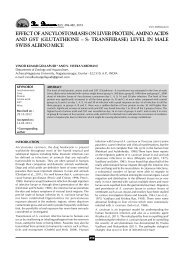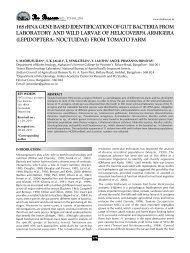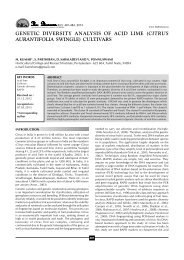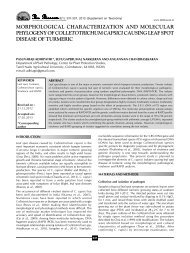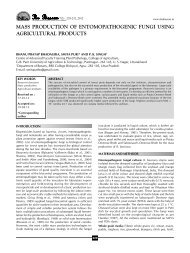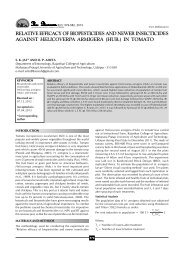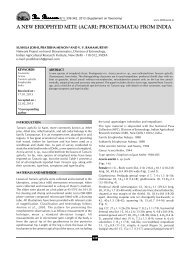full paper - THE BIOSCAN
full paper - THE BIOSCAN
full paper - THE BIOSCAN
You also want an ePaper? Increase the reach of your titles
YUMPU automatically turns print PDFs into web optimized ePapers that Google loves.
NSave Nature to Survive<br />
5 (1) : 13-18, 2010<br />
TO TOXICITY TO TOXICITY<br />
XICITY OF OF BINAR BINARY BINAR Y COMBINA COMBINATION COMBINA COMBINA TION OF OF SARA SARA SARACA SARA A ASOC ASOC ASOCA ASOC AND<br />
AND<br />
THUJ THUJA THUJ THUJA<br />
A ORIENT ORIENTALIS<br />
ORIENT ALIS WITH WITH SYNERGIST SYNERGIST PIPERONYL PIPERONYL BUTO BUTOXIDE BUTO XIDE AND AND<br />
AND<br />
MGK MGK-264 MGK -264 A AAGAINST<br />
A AINST AINST <strong>THE</strong> <strong>THE</strong> FRESHW FRESHWATER FRESHW TER SNAIL SNAIL LYMNAEA YMNAEA AA<br />
ACUMINA AA<br />
CUMINA CUMINATA<br />
CUMINA<br />
ARUNDHATI SINGH, PRADEEP KUMAR, D. K. SINGH AND V. K. SINGH*<br />
Department of Zoology, D. D. U. Gorakhpur University,<br />
Gorakhpur - 273 009, U. P., INDIA<br />
E-mail: vksingh_gpu@yahoo.co.in<br />
KEY WORDS<br />
Fascioliasis<br />
Piperonyl butoxide<br />
MGK-264 (ENT 8184)<br />
Saraca asoca<br />
Thuja orientalis<br />
Lymnaea acuminata<br />
Received on :<br />
05.10.2009<br />
Accepted on :<br />
13.01.2010<br />
*Corresponding<br />
author<br />
INTRODUCTION<br />
ABSTRACT<br />
The molluscicidal activity of leaf/ bark of Saraca asoca, leaf/fruit of Thuja orientalis and their active components/<br />
column purified fraction with synergist Piperonyl butoxide (PB) and MGK-264 (ENT 8184) were studied in<br />
binary combination (1:5) against Lymnaea acuminata. Combination of S. asoca leaf/ column extract of S. asoca<br />
leaf or bark with PB or MGK-264 is more toxic than their single treatment. Highest degree of synergism i.e.323<br />
times was observed in the combination of S. asoca leaf with PB or MGK-264 at 96h exposure period.<br />
Combination of T. orientalis leaf/ thujone or fruit powder/ column extract of T. orientalis fruit with PB or<br />
MGK-264 indicate that it enhance the toxicity up to 189.02 times. Toxicity of binary combination was<br />
increased hundreds folds than their individual components indicating synergistic action.<br />
Fascioliasis is very common in eastern Uttar Pradesh, 94%<br />
buffaloes slaughtered in local slaughter houses are infected<br />
with Fasciola gigantica (Singh and Agarwal, 1981; Agarwal<br />
and Singh, 1988). The fresh water snail Lymnaea acuminata<br />
serve as intermediate hosts of parasitic flat worm, Fasciola<br />
and Schistosoma species (Mas-Coma et al., 2005; Osman et<br />
al., 2007). In human the disease is characterised by<br />
hypereosinophilia, abdominal pain and pancreatitis (Saba et<br />
al., 2004; Singh and Singh 2009a). One of the solutions to<br />
reduce the problem of fascioliasis is to disrupt the life cycle of<br />
the fluke by eliminating the vector snails (Godan, 1983; Jaiswal<br />
and Singh, 2008). Several attempts have been made to reduce<br />
the incidence of fascioliasis by using synthetic molluscicides<br />
and plant product molluscicides (Singh et al., 1996; Kumar<br />
and Singh, 2007). The continuous and indiscriminate use of<br />
synthetic pesticides for vector control has created the problem<br />
of acute and chronic toxicity to environment (Shafer et al.,<br />
2005; Singh et al., 2009). It has been observed that the plant<br />
derived molluscicides are easily available, less expensive and<br />
biodegradable in nature than their synthetic counterparts. It<br />
has been previously reported by us Saraca asoca and Thuja<br />
orientalis are potent molluscicides (Singh and Singh, 2009b).<br />
In the present study we have evaluated the toxicity of binary<br />
combination of Saraca asoca (Family- Caesalpiniaceae) leaf /<br />
bark and Thuja orientalis (Family- Cupressaceae) leaf/fruit with<br />
synergist piperonyl butoxide (PB) and MGK-264 (ENT 8184)<br />
13<br />
against Lymnaea acuminata.<br />
MATERIALS AND METHODS<br />
Test material<br />
Snail Lymnaea acuminata were collected locally from the<br />
ponds, pools and lakes of Gorakhpur district and used for<br />
toxicity testings. These snails either adhere to ventral surface<br />
of the leaves of aquatic plants or, lie freely around the vegetation<br />
near the banks and are available round the year. Snails are<br />
kept in glass aquarium containing dechlorinated tap water<br />
and were allowed to acclimatize to the laboratory condition<br />
for 72h. Dead animal were removed immediately to prevent<br />
any contamination in the aquarium water. The average sized<br />
adults of Lymnaea acuminata (2.30 ± 0.25 cm in length)<br />
were used as the experimental animals.<br />
Binary combination<br />
Binary combination of crude powder of S. asoca leaf/bark<br />
and T. orientalis leaf/fruit and its active components/column<br />
purified fractions (Singh and Singh, 2009b) with synergist PB<br />
and MGK-264 in 1:5 ratios were used for the determination of<br />
molluscicidal activity.<br />
Molluscicidal activity<br />
The Synergistic toxicity against L. acuminata was performed<br />
by method of Singh and Agarwal (1984). Ten experimental<br />
animals were kept in a glass aquarium, containing 3 lit of
ARUNDHATI SINGH et al.,<br />
dechlorinated tap water. Snails were exposed to different<br />
preprations of S. asoca leaf/ bark and T. orientalis leaf/ fruit<br />
singly and binary combinations with synergist PB or MGK-<br />
264 (Table 1) to observe their toxicity against L. acuminata.<br />
Six aquaria were set up for each concentration. Mortality was<br />
recorded at 24 h intervals up to 96 h exposure period. Control<br />
animals were kept in an equal volume of dechlorinated water<br />
under similar condition without treatment.<br />
Lethal concentration value (LC 50 ), upper and lower confidence<br />
limit (UCL and LCL) and slope values were calculated<br />
according to POLO computer programme of Robertson et al.,<br />
(2007). The regression coefficient was determined between<br />
exposure time and different values of LC 50 (Sokal and Rohlf,<br />
1976).<br />
RESULTS<br />
Binary combination of S. asoca leaf powder with PB or MGK-<br />
264 was 16.35 and 22.2 times, more toxic against L. acuminata<br />
than their single treatment at 24h. At 96h exposure period<br />
toxicity of S. asoca leaf powder with PB or MGK-264 were<br />
enhanced to 26.64 or 25.29 times, respectively. Binary<br />
combination of column purified of S. asoca leaf powder with<br />
PB or MGK-264 was 99.62 or 132.83 times, more toxic against<br />
L. acuminata than their single treatment at 24h. At 96 h<br />
exposure period’s toxicity of column purified of S. asoca leaf<br />
powder with PB or MGK-264 were enhanced 323 times (Table,<br />
2).<br />
The 96h toxicity of column purified of S. asoca leaf powder<br />
with PB (LC - 0.01 mg/L) and the column purified of S. asoca<br />
50<br />
Table 2: Toxicity of binary combination (1:5 ratio) of Saraca asoca (leaf powder) and column purified fraction with synergist MGK-264 or PB<br />
against Lymnaea acuminata<br />
Exposure period/<br />
Molluscicides<br />
LC50 mg/L<br />
Synergi<br />
stic ratio<br />
Limits<br />
LCL UCL<br />
Slope<br />
value<br />
t-ratio g-value Heterogeneity<br />
24h Leaf powder 84.24 74.26 102.33 3.62±0.60 6.03 0.10 0.27<br />
Leaf powder + MGK 3.79 22.2 3.23 4.88 2.88±0.49 5.85 0.11 0.36<br />
Leaf powder + PB 5.15 16.35 3.94 9.19 2.13±0.46 4.60 0.18 0.46<br />
Column purified 7.97 6.76 10.41 2.95±0.51 5.79 0.11 0.35<br />
Column purified+MGK 0.06 132.83 0.05 0.09 3.65±0.70 5.20 0.14 0.40<br />
Column purified+ PB 0.08 99.62 0.06 0.16 1.57±0.32 4.85 0.16 0.81<br />
48h Leaf powder 69.53 61.15 82.45 3.04±0.51 5.88 0.11 0.17<br />
Leaf powder + MGK 2.94 23.64 2.84 3.71 2.27±0.40 5.58 0.12 0.21<br />
Leaf powder + PB 3.60 19.31 2.87 5.48 1.81±0.40 4.54 0.18 0.23<br />
Column purified 6.35 5.24 8.50 2.05±0.40 5.11 0.14 0.26<br />
Column purified+MGK 0.04 158.75 0.03 0.06 1.59±0.28 5.68 0.11 0.26<br />
Column purified+ PB 0.05 127.00 0.04 0.09 1.36±0.27 4.98 0.15 0.28<br />
72h Leaf powder 53.05 45.19 61.39 2.68±0.48 5.51 0.12 0.10<br />
Leaf powder + MGK 2.17 24.44 1.84 3.12 2.15±0.35 5.48 0.12 0.27<br />
Leaf powder + PB 2.42 21.92 1.94 3.10 1.79±0.37 4.73 0.17 0.27<br />
Column purified 4.39 3.54 5.41 1.93±0.38 5.08 0.14 0.23<br />
Column purified+MGK 0.02 219.5 0.02 0.03 1.41±0.25 5.46 0.12 0.12<br />
Column purified+ PB 0.03 146.33 0.02 0.04 1.24±0.25 5.89 0.16 0.34<br />
96h Leaf powder 39.96 32.45 46.01 2.95±0.49 5.93 0.10 0.16<br />
Leaf powder + MGK 1.58 25.29 1.29 1.84 2.66±0.40 6.61 0.08 0.76<br />
Leaf powder + PB 1.50 26.64 1.22 1.74 2.29±0.40 5.84 0.11 0.81<br />
Column purified 3.23 2.60 3.80 2.48±0.39 6.28 0.09 0.61<br />
Column purified+MGK 0.01 323.00 0.011 0.02 1.51±0.25 5.86 0.11 0.22<br />
Column purified+ PB 0.01 323.00 0.012 0.02 1.62±0.26 6.21 0.10 0.80<br />
Six batches of ten snails were exposed to different concentration of above combination. Mortality was determined every 24h. Concentration given are the final concentration (mg/L, w/<br />
v) in the aquarium water. Synergistic ratio (LC 50 of S. asoca leaf powder or column purified/ LC 50 of binary combination of S. asoca leaf powder or column purified with synergist MGK-<br />
264 or PB). Abbreviations: LCL- lower confidence limits; UCL- Upper confidence limits; MGK- MGK264. Significant negative regression (p
(LC - 1.50 mg/L) was more effective than S. asoca leaf powder<br />
50<br />
with MGK-264 (LC -1.58 mg/L) (Table 3). There was a<br />
50<br />
negative regression between the LC of different combination<br />
50<br />
of S. asoca leaf powder with PB /MGK-264 and different<br />
exposure period 24h LC of binary combination of S. asoca<br />
50<br />
bark powder with PB or MGK-264 was 48.06 or 45.00 mg/l,<br />
respectively, whereas single treatment up to1500 mg/L of S.<br />
asoca bark powder caused no mortality in snail L. acuminata.<br />
Binary combination of saponin with MGK-264 was only 1.07<br />
times more toxic against L. acuminata than their single<br />
treatment at 24h. At 96h exposure period toxicity of saponin<br />
with PB or MGK-264 were not enhanced as synergistic ratio<br />
was 0.48 or 0.39, respectively. There was a negative regression<br />
between the LC of different combination of Saraca asoca<br />
50<br />
bark powder with PB /MGK-264 and different exposure period.<br />
Binary combination of Thuja orientalis leaf powder with PB<br />
or MGK-264 was 51.42 or 82.45 times, more toxic against L.<br />
acuminata than their single treatment at 24h (Table 4). At 96h<br />
exposure period toxicity of T. orientalis leaf powder with PB<br />
or MGK-264 was enhanced 59.51 or 66.63 times,<br />
respectively. Binary combination of thujone with PB or MGK-<br />
264 was 2.4 or 1.16 times, more toxic against L. acuminata<br />
than their single treatment at 24h. At 96h exposure period<br />
toxicity of thujone with PB or MGK-264 were enhanced 27.5<br />
or 21.15 times, respectively. The 96h toxicity of T. orientalis<br />
leaf powder with MGK-264 (LC -3.76 mg/L) against L.<br />
50<br />
acuminata was more effective than the T. orientalis leaf powder<br />
with PB (LC -4.21 mg/L), thujone with MGK-264 (LC – 8.13<br />
50 50<br />
15<br />
TOXICITY OF BINARY COMBINATION AGAINST FRESHWATER SNAIL<br />
mg/L) or PB (LC - 7.57 mg/L), respectively (Table 4). There<br />
50<br />
was a negative regression between LC of the different<br />
50<br />
combination of T. orientalis leaf powder with PB /MGK-264<br />
and different exposure period.<br />
Binary combination of Thuja orientalis fruit powder with PB<br />
or MGK-264 was 70.98 and 173.88 times, more toxic against<br />
L. acuminata than their single treatment at 24h. At 96h<br />
exposure period toxicity of T. orientalis fruit with PB or MGK-<br />
264 were enhanced 133.58 and 187.58 times, respectively.<br />
Binary combination of column purified fraction of T. orientalis<br />
fruit with PB or MGK-264 was 10.74 or 7.43 times, more toxic<br />
against L. acuminata than their single treatment at 24h. At 96h<br />
exposure period toxicity of column purified of T. orientalis<br />
fruit powder with PB or MGK-264 was enhanced 21.75 or<br />
19.77 times, with respect to their single treatment. The 96h<br />
toxicity of column purified fraction of T. orientalis fruit powder<br />
with PB (LC - 0.20 mg/L) against L. acuminata was more effective<br />
50<br />
than the column purified fraction of T. orientalis fruit powder<br />
with MGK-264 (LC – 0.22 mg/L), T. orientalis fruit powder<br />
50<br />
with MGK-264 (LC -1.36 mg/L) and PB (LC - 1.91 mg/L)<br />
50 50<br />
(Table 5). There was a negative regression between the LC of 50<br />
different combination of T. orientalis fruit powder with PB /<br />
MGK-264 and different exposure period.<br />
The slope values were steep and separate estimation of LC<br />
based on each six replicates were found with in the 95%<br />
confidence limits of LC . The‘t’ ratio was greater than 1.96<br />
50<br />
and the heterogeneity factor was less than 1.0, the ‘g’ value<br />
was less than 0.5 at all probability (90, 95, 99) levels.<br />
Table 3: Toxicity of binary combination (1:5 ratio) of Saraca asoca (bark powder) and active component saponin with synergist MGK-264 or<br />
PB against Lymnaea acuminata<br />
Exposure period/<br />
Molluscicides<br />
LC50 mg/L<br />
Synergi-stic<br />
ratio<br />
Limits Slope value<br />
LCL UCL<br />
t-ratio g-value Heterogeneity<br />
24hBark powder - - - - - - -<br />
Bark powder + MGK 45.00 37.03 61.69 2.34±0.39 5.89 0.11 0.27<br />
Bark powder + PB 48.06 39.32 67.37 2.40±0.41 5.77 0.11 0.58<br />
Saponin 7.04 2.49 9.10 2.12±0.38 5.53 0.12 0.26<br />
Saponin + MGK 7.00 1.07 5.72 11.24 1.91±0.38 5.45 0.12 0.40<br />
Saponin + PB 6.79 1.03 5.45 9.63 2.10±0.36 5.72 0.11 0.35<br />
48h Bark powder - - - - - - -<br />
Bark powder + MGK 41.78 32.58 65.91 1.63±0.34 4.69 0.17 0.32<br />
Bark powder + PB 36.41 29.94 48.83 1.99±0.35 5.59 0.12 0.55<br />
Saponin 5.18 4.77 6.04 1.68±0.32 5.17 0.14 0.27<br />
Saponin + MGK 5.20 1.07 3.95 7.81 1.41±0.28 4.97 0.15 0.34<br />
Saponin + PB 4.96 1.12 3.95 6.75 1.73±0.30 5.77 0.11 0.38<br />
72h Bark powder - - - - - - -<br />
Bark powder + MGK 25.17 20.40 31.49 1.81±0.33 5.35 0.13 0.71<br />
Bark powder + PB 17.81 7.72 13.21 2.60±0.44 5.09 0.11 0.76<br />
Saponin 1.13 0.16 2.12 1.39±0.30 4.55 0.18 0.28<br />
Saponin + MGK 3.29 0.34 2.32 4.68 1.19±0.26 4.48 0.19 0.46<br />
Saponin + PB 2.96 0.38 2.21 3.86 1.47±0.27 5.44 0.13 0.26<br />
96h Bark powder - - - - - - -<br />
Bark powder + MGK 16.24 12.49 19.56 2.08±0.35 5.93 0.10 0.99<br />
Bark powder + PB 7.70 4.12 7.06 2.35±0.35 6.65 0.38 0.36<br />
Saponin 0.80 0.06 0.98 2.13±0.32 6.49 0.09 0.67<br />
Saponin + MGK 2.02 0.39 1.49 2.52 1.81±0.27 6.49 0.09 0.78<br />
Saponin + PB 1.66 0.48 1.10 2.17 1.60±0.27 5.81 0.11 0.66<br />
Six batches of ten snails were exposed to different concentration of above combination.Mortality was determined every 24h. Concentrations given are the final concentration (mg/L, w/<br />
v) in the aquarium water. No mortality up to 1500 mg/L. Synergistic ratio (LC of S. asoca bark powder or column purified/ LC of binary combination of S. asoca bark powder or column<br />
50 50<br />
purified with synergist MGK-264 or PB). Abbreviations: LCL- lower confidence limits; UCL- Upper confidence limits; MGK- MGK264.Significant negative regression (p
ARUNDHATI SINGH et al.,<br />
Table 4: Toxicity of binary combination (1:5 ratio) of Thuja orientalis (leaf powder) and active component thujone with synergist MGK-264<br />
or PB against Lymnaea acuminata<br />
Exposure period/<br />
Molluscicides<br />
LC50 mg/L<br />
Synergistic<br />
ratio<br />
Limits<br />
LCL UCL<br />
Slope value t-ratio g-value Heterogeneity<br />
24h Leaf powder 465.89 418.01 550.46 4.15±0.09 6.02 0.10 0.26<br />
Leaf powder + MGK 5.65 82.45 5.16 6.55 4.88±0.86 5.62 0.21 0.24<br />
Leaf powder + PB 9.06 51.42 7.68 12.20 2.87±0.55 5.14 0.145 0.18<br />
Thujone 8.03 4.72 9.49 1.93±0.36 5.23 0.14 0.18<br />
Thujone + MGK 6.89 1.16 14.66 22.40 4.26±0.84 5.04 0.15 0.42<br />
Thujone + PB 3.33 2.4 12.05 15.56 4.21±0.73 5.69 0.11 0.14<br />
48h Leaf powder 391.41 351.02 450.62 3.56±0.61 5.84 0.11 0.19<br />
Leaf powder + MGK 4.97 78.75 4.57 5.54 4.70±0.80 5.83 0.11 0.18<br />
Leaf powder + PB 7.45 52.53 6.22 10.16 2.13±0.48 4.37 0.20 0.16<br />
Thujone 6.59 4.61 8.56 1.74±0.32 5.29 0.13 0.19<br />
Thujone + MGK 4.68 1.4 12.64 20.16 3.02±0.70 4.27 0.21 0.20<br />
Thujone + PB 1.15 5.73 9.97 12.79 3.40±0.68 4.98 0.15 0.16<br />
72h Leaf powder 321.17 280.57 362.95 3.15±0.59 5.42 0.13 0.21<br />
Leaf powder + MGK 4.31 74.51 3.95 4.70 4.66±0.78 5.96 0.10 0.24<br />
Leaf powder + PB 5.55 57.86 4.42 6.96 1.88±0.46 4.01 0.23 0.10<br />
Thujone 4.62 2.26 7.16 1.35±0.30 4.40 0.19 0.26<br />
Thujone + MGK 0.22 21.0 8.86 11.75 2.96±0.67 4.41 0.19 0.24<br />
Thujone + PB 0.18 25.66 7.89 10.27 3.36±0.68 4.92 0.15 0.20<br />
96h Leaf powder 250.55 215.99 278.38 4.05±0.62 6.54 0.09 0.28<br />
Leaf powder + MGK 3.76 66.63 3.45 4.03 5.93±0.84 7.05 0.07 0.65<br />
Leaf powder + PB 4.21 59.51 3.45 4.83 2.89±0.49 5.04 0.11 0.55<br />
Thujone 2.75 1.88 4.44 2.12±0.33 6.43 0.09 0.76<br />
Thujone + MGK 0.13 21.15 7.14 8.89 4.69±0.76 6.17 0.10 0.80<br />
Thujone + PB 0.10 27.5 6.37 8.41 4.29±0.75 5.66 0.12 0.39<br />
Six batches of ten snails were exposed to different concentration of above combination.Mortality was determined every 24h. Concentrations given are the final concentration (mg/L, w/<br />
v) in the aquarium water. Synergistic ratio (LC of T. orientalis leaf powder or Thujone/ LC of binary combination of T. orientalis leaf powder or thujone with synergist MGK-264 or<br />
50 50<br />
PB). Abbreviations: LCL- lower confidence limits; UCL- Upper confidence limits; MGK- MGK264. Significant negative regression (P
DISCUSSION<br />
Binary combination of S. asoca, and T. orientalis with PB and<br />
MGK-264 show effective molluscicidal activity than their single<br />
treatment against the snail L. acuminata. The molluscicidal<br />
activity of these combinations was time and concentration<br />
dependent. A number of studies on binary combination of<br />
plant derived molluscicides with PB and MGK-264 have been<br />
conducted against harmful snails (Singh et al., 1998a b; Singh<br />
and Singh 2003; Singh et al., 2005; Shukla et al., 2005).<br />
Action of binary mixture is non-interactive (Plackett and<br />
Hewlett, 1952) as the components do not affect the transport<br />
and final concentration of each other at the site of action.<br />
Piperonyl butoxide and MGK-264 alone are not toxic to snail<br />
L. acuminata (Singh and Agarwal, 1989; Sahay et al., 1991).<br />
Piperonyl butoxide and MGK-264 are commonly used with<br />
carbamates, organophosphates, pyrethroids pesticides and<br />
certain plant derived pesticides to increase their efficacy against<br />
different pests (Casida, 1970; Sahay et al., 1991; Rao and<br />
Singh, 2001). They exert their synergistic action mainly by<br />
inhibiting the mixed function oxidase (MFO) activity, which<br />
detoxify xenobiotics (Metacalf, 1967; Matsumura, 1985; Rao<br />
and Singh, 2001) or it may increase the penetration of the<br />
toxin which resulted high titer of toxin at active sites (Rao and<br />
Singh, 2001). The penetration of the toxicant also have a greater<br />
significant for the aquatic environment, because here the whole<br />
body is bathed in a diluted solution of the toxicant. To have<br />
maximum effect, the synergist must penetrate the organism<br />
and transported to active sites rapidly. It seems that high level<br />
of synergism in snails may be due to rapid penetration of<br />
synergists through soft foot of snails.<br />
Toxicity of S. asoca leaf with PB or MGK-264 (96h LC 50 -1.50<br />
mg/L and 1.58 mg/L), B. nigra seed with PB or MGK-264 (96h<br />
LC 50 - 2.06 mg/L and 1.63 mg/L), T. orientalis leaf with PB or<br />
MGK-264 (96h LC 50 - 4.21 mg/L and 3.76 mg/L ) and T.<br />
orientalis fruit with PB or MGK-264 (96 LC 50 – 1.91 mg/L and<br />
1.36 mg/L) against the snail L. acuminata in the present study<br />
is very high in comparison to synthetic pesticides viz. carbaryl<br />
(96h LC 50 -14.4 mg/L), phorate (96h LC 50 -15.0 mg/L ), aldicarb<br />
(96 LC 50 - 11.5 mg/L), and farmothion (96h LC 50 - 8.56 mg/L)<br />
(Singh and Agarwal, 1983a, b). Toxicity of column extract of<br />
S. asoca leaf with PB or MGK-264 (96h LC 50 -0.01 mg/L and<br />
0.01 mg/L), and column extract of T. orientalis fruit with PB or<br />
MGK-264 (96h LC 50 -0.20 mg/L and 0.22 mg/L) against the<br />
snail L. acuminata is very high in comparison to synthetic<br />
pyrethroids pesticides permethrin (96h LC 50 -0.37 mg/L),<br />
cypermethrin (96h LC 50 -0.36 mg/L), and organophosphate<br />
pesticide trichlorfon (96h LC 50 -0.30 mg/L), (Singh and Agarwal,<br />
1991, 1986a, b, ). Combination of S. asoca leaf/ column extract<br />
of S. asoca leaf or bark with PB or MGK-264 is more toxic than<br />
their single treatment. Highest degree of synergism i.e.323<br />
times was observed in the combination of S. asoca leaf with<br />
PB or MGK-264 at 96h exposure period. Contrarily,<br />
combination of PB or MGK-264 with saponin caused no<br />
significant synergistic activity. It clearly demonstrates that either<br />
the molluscicidal activity of S. asoca leaf/bark may be due to<br />
saponin as well as other component whose activity is enhanced<br />
by the combination of PB or MGK-264. PB or MGK-264 is the<br />
mixed function oxidase inhibitors (Wilkinson, 1976;<br />
Matsumura, 1985). Due to inhibition of mixed function oxidase<br />
17<br />
the active components is not detoxified, and there is high titer<br />
of molluscicidal component at target site. Although, in the<br />
present study activity of saponin is identified as molluscicidal<br />
component, yet no synergistic action with PB or MGK-264<br />
demonstrate that inside the snail body it is not detoxified by<br />
the mixed function oxidase. At higher exposure period there<br />
is some antagonistic action as the synergistic ratio is less than<br />
1.0. It also indicates that saponin/ PB/MGK-264 target in snail<br />
body may be same, so that the toxicity of saponin is<br />
antagonized by PB or MGK-264.<br />
Combination of T. orientalis leaf/ thujone or fruit powder/<br />
column extract of T. orientalis fruit with PB or MGK-264 indicate<br />
that it enhance the toxicity up to 189.02 times. Potentiation of<br />
molluscicidal activity of T. orientalis fruit with PB or MGK-264<br />
clearly indicate that in contrast to saponin, T. orientalis leaf/<br />
thujone toxicity is synergized more effectively. It demonstrates<br />
that mfo inhibitor PB or MGK-264 check the detoxification of<br />
thujone in the snail body, which cause several times<br />
enhancement in their toxicity against L. acuminata. Highest<br />
concentration of PB (300.54 mg/L) and MGK-264 (260.50<br />
mg/L) mixture are not toxic to snail as reported earlier by Singh<br />
and Agarwal, (1989) and Sahay et al., (1991).<br />
The steep slope indicates that even a small increase in the<br />
concentration causes higher snail mortality. Values of t- ratio<br />
higher than 1.96 indicate, that the regression is significant.<br />
Values of heterogeneity factor is less than 1.0 denote that in<br />
the replicates test of random sample the concentration<br />
response curves fall within the 95% confidence limits and<br />
thus the model fits the data adequately. The index of<br />
significance of potency estimation, g-value indicates the value<br />
of the mean is within the limits at all probabilities (90, 95, 99)<br />
since it is less than 0.5.<br />
It can be concluded from the present study that the use of<br />
synergist in binary combination will be more helpful in<br />
controlling the population of snails in threshold level. The<br />
effective concentration in combination is certainly lower than<br />
their individual component.<br />
REFERENCES<br />
TOXICITY OF BINARY COMBINATION AGAINST FRESHWATER SNAIL<br />
Agarwal, R. A. and Singh, D. K. 1988. Harmful gastropods and their<br />
control. Acta Hydrochim. Hydrobiol. 16: 113-138.<br />
Casida, J. E. 1970. Mixed-function oxidase involvement in the<br />
biochemistry of insecticide synergist. J. Agric. Food. Chem. 12: 294-<br />
304.<br />
Godan, D. 1983. Pest Slugs and Snails, Biology and Control (de.<br />
Dora godan) translated by Shelia Gruber, Springer verlog, Berlin,<br />
Heidelberg, New York.<br />
Jaiswal, P. and Singh, D. K. 2008. Molluscicidal activity of Carica<br />
papaya and Areca catechu against the fresh water snail Lymnaea<br />
acuminata. Vet. Parasitol. 152: 264-270.<br />
Kumar, P. and Singh, D. K. 2007. Binary combination of some<br />
common spices against harmful snails. J. Appl. Biosci. 33(2): 167-<br />
170.<br />
Mas-Coma, S., Bargues, M. D. and Valero, M. A. 2005. Fascioliasis<br />
and other plant- borne trematode zoonose. Int. Parasitol. 35: 1255-<br />
1278.<br />
Matsumura, F. 1985. Toxicology of Insecticides. 2nd Ed. Plenum Press,<br />
New York.
ARUNDHATI SINGH et al.,<br />
Metacalf, R. L. 1967. Mode of action of insecticide synergists. Ann.<br />
Rev. Entomol. 112: 229-256.<br />
Osman, E. A., Mohamed, E. M., Abu Elreesh, B. I. and Elegami, A. A.<br />
2007. Molluscicidal activity of Combretum glutinosum. International<br />
J. of Mole. Med. And Adv. Sci. 3 (4): 151- 154.<br />
Plackett, R. L. and Hewlett, P. S. 1952. Quantal responses to mixtures<br />
of poisons, J. R. Statist. Soc. B. 14: 141-63.<br />
Rao, I. G. and Singh, D. K. 2001. Combination of Azadirachta indica<br />
and Cedrus deodara oil, with piperonyl butoxide, MGK-264 and<br />
Embelia ribes against Lymnaea acuminata. Chemosphere 14: 1691-<br />
1695.<br />
Robertson, J. L. Russell, R. M., Preisler H. K. and Savin, N. E. 2007.<br />
Bioassay with Arthropods POLO computer programme for analysis<br />
of bioassay data. 2nd Eds (Talor and Francis, CRC Press) 1-224pp.<br />
Sahay, N., Singh, D. K. and Agarwal, R. A. 1991. Synergistic effect of<br />
piperonyl butoxide on the toxicity of synergistic pyrethroids in the<br />
Lymnaea acuminata. J. Med. Appl. Malacol. 3: 107-111.<br />
Saba, R. Korkmaz, M., Inan, D., Mamikoglu, L., Turhan, O., Gunseren,<br />
F., Cevikol, C. and Kabaalioglu, A. 2004. Human fascioliasis. Clinical<br />
microbial. Infection 10: 385-387.<br />
Shafer, T. J., Meyer, D. A. and Crofton, K. M. 2005. Developmental<br />
neurotoxicity of pyrethroid insecticides: critical review and future<br />
research needs. Environ. Health Persp. 113: 123-136.<br />
Shukla, S., Singh, V. K. and Singh, D. K. 2005. Binary and tertiary<br />
combinations of plant derived molluscicides against the vector snails<br />
Lymnaea acuminata and Indoplanorbis exustus. Malys. Appl. Biol.<br />
34(2): 15-24.<br />
Singh, A., Singh, D. K., Mishra, T. N. and Agarwal, R. A. 1996.<br />
Molluscicide of Plant origin. Bio. Agric. and Horti. 13: 205-252.<br />
Singh, D. K. and Agarwal, R. A. 1984. Correlation of the<br />
anticholinesterase and molluscicidal activity of the latex of Euphorbia<br />
royleana on the snail L. acuminata. J. of Nat. Prod. 47: 702-705.<br />
Singh, D. K. and Agarwal, R. A. 1986a. Synergistic effect of sulfoxide<br />
with carbaryl on the in vivo acetylcholinesterase activity and<br />
carbohydrate metabolism of the snail L. acuminata. Acta Hydrochim.<br />
Hydrobiol. 14(4): 421-427.<br />
Singh, D. K. and Agarwal, R. A. 1986b. Piperonyl butoxide synergism<br />
with two synthetic pyrethroids against L. acuminata. Chemosphere.<br />
15: 493-498.<br />
Singh, D. K. and Agarwal, R. A. 1989. Toxicity of piperonyl butoxidecarbaryl<br />
synergism on the snail L. acuminata. Int. Revue. Ges.<br />
18<br />
Hydrobiol. 74(6): 689-699.<br />
Singh, D. K. and Agarwal, R. A. 1991. Action sites of cypermethrin,<br />
a synthetic pyrethroid in the snail L. acuminata. Acta Hydrochim.<br />
Hydrobiol. 19(4): 425-430.<br />
Singh, K., Singh, A. and Singh, D. K. 1998a. Synergism of MGK-264<br />
and piperonyl butoxide on the toxicity of plant derived molluscicides.<br />
Chemosphere. 36: 3055-3060.<br />
Singh, K., Singh, A. and Singh, D. K. 1998b. The use of piperonyl<br />
butoxide and MGK-264 to improve the efficacy of some plant derived<br />
molluscicides. Pestic. Sci. 54: 145-149.<br />
Singh, O. and Agarwal, R. A. 1981. Toxicity of certain pesticides to<br />
two economic species of snails in northern India. J.Econ. Entomol.<br />
74: 568-571.<br />
Singh, P. and Singh, D. K. 2003. Toxicity of binary combinations of<br />
plant derived molluscicides with MGK-264 and piperonyl butoxide<br />
against L. acuminata. Biol. Memoirs. 29(2): 78-84.<br />
Singh, P., Singh, V. K. and Singh, D. K. 2005. Effect of binary<br />
combination of some plant derived molluscicides with MGK-264 or<br />
piperonyl butoxide on the reproduction of the snail L. acuminata.<br />
Pes. Manag. Sci. 61: 204-208.<br />
Singh, V. and Singh, D. K. 2009a. The effect of abiotic factors on the<br />
toxicity of cypermethrin against the snail Lymnaea acuminata in the<br />
control of fascioliasis. J Helminthology 83: 39-45.<br />
Singh, A. and Singh, V. K. 2009b. Molluscicidal activity of Saraca<br />
asoca and Thuja orientalis against the fresh water snail Lymnaea<br />
acuminata. Vet. Parasitol. 164: 206-210.<br />
Singh, P., Kumar, P., Singh V. K. and Singh, D. K. 2009. Effect of snail<br />
attractant pellets containing plant molluscicides on certain enzymes<br />
in the nervous tissue of Lymnaea acuminata. The Bioscan 4(3): 395-<br />
398.<br />
Singh, D. K. and Agarwal, R. A. 1983a. In vivo and in vitro studies on<br />
synergism with anticholinesterase pesticides in the snail Lymnaea<br />
acuminata. Arch. Environ. Cantam. Toxicol. 12: 483-487.<br />
Singh, D. K. and Agarwal, R. A. 1983b. Inhibition kinetics of certain<br />
organophosphorous and carbamate pesticides on acetylcholinesterase<br />
from the snail Lymnaea acuminata. Toxicology Letters 19: 313-319.<br />
Sokal, R. R. and Rohlf, F. J. 1976. Introduction to Biostatistics.<br />
Freemann, W. H., San Francisco. p.368.<br />
Wilkinson, C. F. 1976. Insecticide synergism. In: R. L. Metcalf and J.<br />
J. Mckelvey (eds). The future for insecticide need and prospects. New<br />
York, Awily Interscience, p.195.



